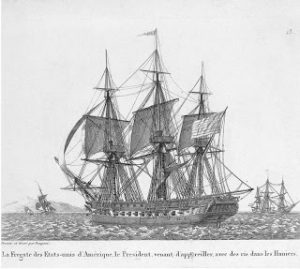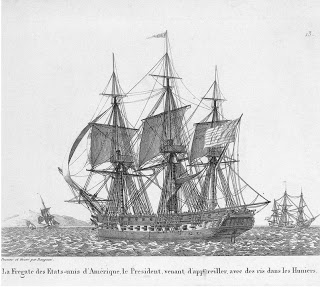Constitution has been around so long and become so famous that sometimes we have a hard time remembering she was once just one ship among many. The men who sailed on board during the first decade of the nineteenth century, before the string of wartime victories, saw little in the ship’s form to celebrate. In fact, some were downright critical of the ship’s accommodations and performance.
Part of the ambivalence stemmed from the lackadaisical maintenance given the ship. When John Rodgers had the ship “hove out” in April 1808, he “discovered that her Main Keel, directly in the wake of the scarf of the Stem, was considerably mutilated for the space of 3 1/2 feet, and that about sixty feet of her false keel was entirely off.”1 New York Navy Yard workers made repairs, and later in the year Rodgers could report, “The Constitution I find possesses all her former good qualities, and with a little more practice, I think her crew will be a very good one.”2 Secretary Paul Hamilton was “very much pleased to hear of the excellent properties of the frigate Constitution. From the reports made to me, it appears that all the Vessels which have lately been repaired, are much improved in their sailings, masting, sparring, rigging, and internal arrangements.”3
Despite the pleasantries exchanged by the Commodore and Secretary, the men who had direct experience with the ship harbored different feelings. Midshipman Thomas Holdup, who had served on Constitution for some time and had lately been transferred to the President, indulged in a little compare and contrast in a letter to Lt. Ralph Izard. Besides giving us a glimpse of Constitution on the eve of the war, the letter illustrates the differences between so-called sister ships, especially after twelve years of service and refits.
“This Ship [President] differs very much from the Constitution both in her Sailing and Rigging, and also her Accommodations; for she sails much better, and is much lighter rigged – Her Birth [sic] Deck is superior as also her Cabin, Ward-Room & Steerage all of which have the convenience of Air Ports- her Gun Deck and Fore-Castle are better; but her Quarter-Deck in my opinion is not as large – her Cockpit and Store Rooms are far superior to the Constitutions – The Master’s Boswain’s, Gunner’s, and Carpenter’s Store Rooms are forward on the Birth-Deck- her Lower Topsail, Top Gallent and Royal Yards are much lighter, than the Constitution’s; her Standing Rigging is smaller; but the stuff is much inferior; her running rigging is in some respects smaller but very disproportioned; and leads very irregular, but I believe the Comre. intends having it altered: the Eyes of her Standing Rigging are very large; and all of the Rigging is obliged to be kept very slack; for the least alteration in setting it up, would eventually destroy her sailing; but upon the whole I am very much pleased with this Ship and prefer her to the Constitution.”4

By this time, John Rodgers apparent shared Mid. Holdup’s opinion. In a letter to the Secretary, he wrote, “A few days since I had an opportunity of comparing the sailing of the President & Constitution & I think, since the latter has got her bottom cleansed, that she is the fastest sailing Vessel that the President has met with, since I commanded her; indeed, the difference is not very material, altho’ the President is decidedly the fastest Ship of the two‑‑”5
Evidently, William Bainbridge and Naval Constructor Josiah Barker thought the ship could use some improvement also, and when Constitution underwent extensive repairs in 1813, they seem to have rearranged many of the ship’s interior spaces. That the result was more successful than her earlier arrangements is made clear by yet another letter to John Rodgers.
In the spring of 1814 William Jones wrote to Commodore Rodgers, who was then overseeing the construction of a new 44-gun frigate in Philadelphia called the Guerriere. As the ship neared completion, Rodgers bombarded the Secretary with letters, and on May 11 Jones gave positive instructions for the ship’s interior fittings: “The plan of the inboard works entire was forwarded sometime since. It is the Counterpart of that by which the Constitution was finished on her last repair, on which much attention was bestowed and I wish the plan adhered to.”6
Perhaps the Secretary derived some pleasure from the fact that the “inboard works” of the ship named for Constitution’s first wartime capture would follow the plans of the captor herself. This bit of information is too tantalizing to ignore, because to date no plans of Constitution’s interior arrangements during the war (save for an 1816 orlop deck plan) have surfaced. Howard Chapelle, in his History of the American Sailing Navy, offers profile and deck plans of USS Guerriere’s internal fixtures, but his source is not entirely clear. Is it possible that a copy of the plans forwarded to Com. Rodgers in 1813 still exists in the recesses of the National Archives? As usual, more research is required.
1 John Rodgers to Paul Hamilton, 29 April 1808, Captain’s Letters to the Secretary of the Navy, M125, National Archives.
2 John Rodgers to Paul Hamilton, 1 Sept. 1809, Captain’s Letters.
3 Paul Hamilton to John Rodgers, 21 Nov. 1809, Secretary of the Navy Letters to Officers, M149, National Archives.
4 Thomas Holdup to Ralph Izard, 19 July 1810, in Stevens Family Papers, Library of Congress.
5 John Rodgers to Paul Hamilton, 17 Sept. 1810, Captain’s Letters.
6 William Jones to John Rodgers, 11 May 1814, Secretary’s Letters.
The Author(s)
Matthew Brenckle
Research Historian, USS Constitution Museum
Matthew Brenckle was the Research Historian at the USS Constitution Museum from 2006 to 2016.
